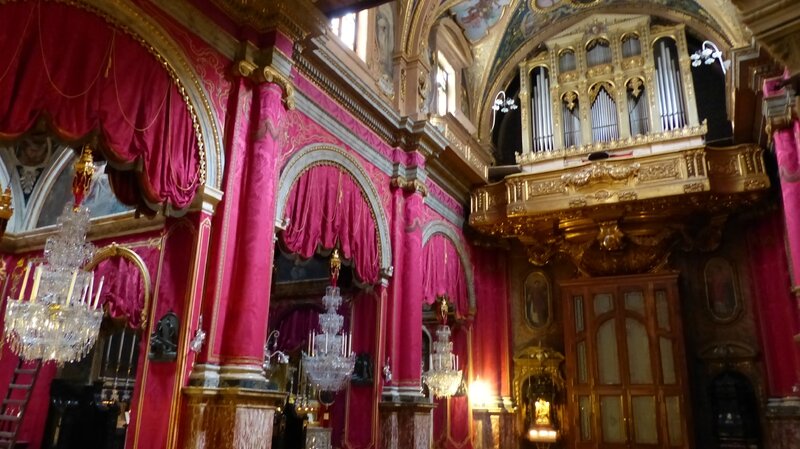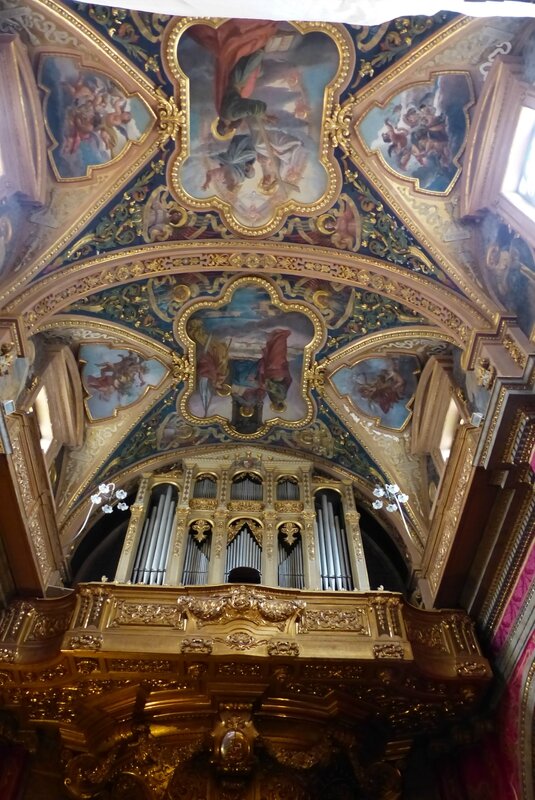L'Eglise Saint-Paul à Valletta, Malta (St-Paul Shipwrecked Church)
Construite en 1639 par l'architecte Gorgona, l'une des plus anciennes églises de la Valette, elle fut dédiée à Saint-Paul, qui fit naufrage à Malte en 60, où il réussit à convertir au christianisme le gouverneur Publius, faisant de Malte une des premières terres chrétiennes de l'Empire romain.
L'intérieur baroque est richement décoré. L'on peut être surpris voire se trouver mal à l'aise devant les draperies recouvrant les murs de leur couleur très particulière, ou bien sensible à l'originalité de cette décoration.
Une belle statue de bois datée du XVIIe siècle et signée de Melchiore Gafà est portée en procession en février lors de la fête commémorant le naufrage du saint.
Trois statues de taille plus modeste sont installées dans des présentoirs (ci-dessous). Je n'en sais pas plus à leur sujet et serais heureux d'en apprendre davantage.
Pour en savoir un petit peu plus sur l'édifice et en Français :
https://fr.wikipedia.org/wiki/Église_collégiale_du_naufrage_de_saint_Paul_de_La_Valette
Quelques mots en anglais :
Christianity has almost 2000 years of history in Malta. According to tradition, it was brought to the Islands by none other than the Apostle Paul himself in around A.D. 60.
Paul was being taken to Rome to be tried as a political rebel, but the ship carrying him and some 274 others was caught in a violent storm only to be wrecked two weeks later on the Maltese coast. All aboard swam safely to land.
The site of the wreck is traditionally known as St. Paul's Island, and is marked by a statue commemorating the event.
The welcome given to the survivors is described in the Acts of the Apostles (XXVIII) by St. Luke:
"And later we learned that the island was called Malta.
And the people who lived there showed us great kindness,
and they made a fire and called us all to warm ourselves... "
As the fire was lit, Paul was bitten by a poisonous snake but he suffered no ill effects. The islanders took this as a sign that he was a special man. This scene is depicted in many religious works of art on the Islands.
According to tradition, the Apostle took refuge in a cave, now known as St. Paul's Grotto in Rabat, Malta.
During his winter stay, he was invited to the house of Publius, the Romans' chief man on the Islands. It was here, according to tradition, that Paul cured Publius' father of a serious fever. Publius is then said to have converted to Christianity and was made the first Bishop of Malta. The Cathedral of Mdina is said to stand on the site of Publius' house.
Archaeological evidence seems to support this tradition, as Malta was one of the first Roman colonies to convert.
*
Lien : voir l'article sur la Grotte, les catacombes et l'Eglise Saint-Paul à Rabat.
*















/http%3A%2F%2Fstorage.canalblog.com%2F65%2F85%2F318405%2F109972346_o.jpg)
/http%3A%2F%2Fstorage.canalblog.com%2F23%2F77%2F318405%2F109331370_o.jpg)
/http%3A%2F%2Fstorage.canalblog.com%2F51%2F48%2F318405%2F109127937_o.jpg)
/http%3A%2F%2Fstorage.canalblog.com%2F47%2F74%2F318405%2F108975448_o.jpg)
/https%3A%2F%2Fprofilepics.canalblog.com%2Fprofilepics%2F2%2F7%2F274529.jpg)
/https%3A%2F%2Fstorage.canalblog.com%2F19%2F83%2F318405%2F119269037_o.jpeg)
/https%3A%2F%2Fstorage.canalblog.com%2F67%2F13%2F318405%2F116429197_o.jpg)
/https%3A%2F%2Fstorage.canalblog.com%2F93%2F85%2F318405%2F113861122_o.jpg)
/https%3A%2F%2Fstorage.canalblog.com%2F90%2F07%2F318405%2F109270558_o.jpg)
/https%3A%2F%2Fstorage.canalblog.com%2F90%2F94%2F318405%2F106033971_o.jpg)